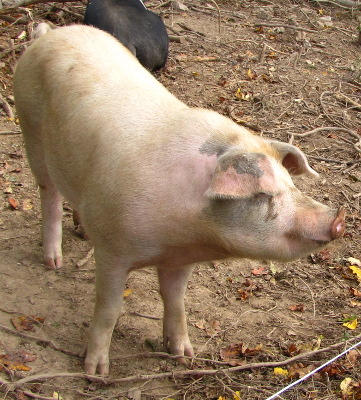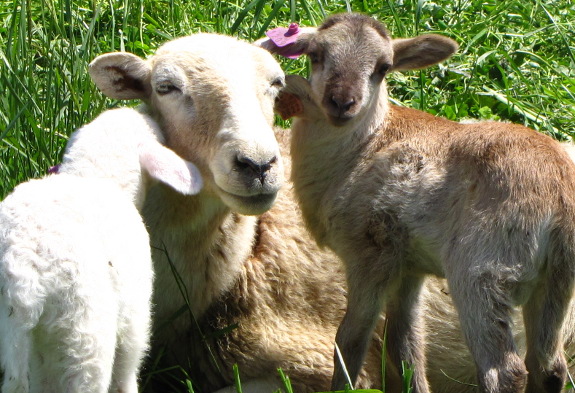
Integrating livestock into an efficient homestead
 For me, the most interesting part
of Fairlie's
book is his
suggestions for integrating livestock into permaculture systems.
The idea is that if your animals have jobs other than just meat
production, they are no longer an inefficient use of land.
For me, the most interesting part
of Fairlie's
book is his
suggestions for integrating livestock into permaculture systems.
The idea is that if your animals have jobs other than just meat
production, they are no longer an inefficient use of land.
The most obvious
non-edible use of livestock is collecting the animals' manure to
fertilize the garden. However, Fairlie points out that even
there, fertilizing your garden with animal manure is about 10% to 43%
less land-efficient per calorie than setting aside a third of the
growing area to produce legume and grain compost crops. (The
different percentages depend on what type of animal you're raising to
make the manure, and both factor in the value of the meat and/or dairy
produced by the animals as well as by the crops.)
While you lose some
land-efficiency by depending on animals to concentrate organic matter
and nitrogen, traditional societies have long known that livestock are
worth the effort in varied landscapes. Grazers
on non-arable land will eat up nitrogen (atmospherically deposited or
fixed by legumes) and bring it home when they come to the stable at
night, then their manure can be used to fertilize the main growing
area. In other words, animals are acting as self-powered
nitrogen-accumulators, a bit like you might plant dynamic
accumulators in the
garden to bring up minerals from the subsoil that your garden plants
can't usually reach.
Meanwhile, livestock can
be a good buffer against famine, especially in the absence of
refrigeration. You can fatten a pig during a time of plenty, then
kill it and eat the meat when the days get short and not much is
growing. On a larger scale, Fairlie considers eating meat to be a
buffer against large-scale problems --- if we're used to the
inefficiency of feeding grains to pigs and eating the pigs, when times
get tough, we can just eat the grains and have a bit of wiggle room to
change what we're doing before we really go hungry.
 In general, though, the biggest bonus of
animals if you're trying to save energy is that they move by
themselves. If we used our livestock to transport people and
heavy objects, to mow between orchard trees, to clear new land, to turn
compost, and to control insects in our gardens, they would probably
look a lot more efficient than they do now. On the other hand, as
enticing as it is to consider returning to a previous era when a rugged
dairy cow might be expected to give milk and also to haul our supplies
through the mud from the parking area, energy is just so cheap at the
moment that mechanized transportation seems to make more sense.
In general, though, the biggest bonus of
animals if you're trying to save energy is that they move by
themselves. If we used our livestock to transport people and
heavy objects, to mow between orchard trees, to clear new land, to turn
compost, and to control insects in our gardens, they would probably
look a lot more efficient than they do now. On the other hand, as
enticing as it is to consider returning to a previous era when a rugged
dairy cow might be expected to give milk and also to haul our supplies
through the mud from the parking area, energy is just so cheap at the
moment that mechanized transportation seems to make more sense.
Perhaps the real lesson
homesteaders should take away from Fairlie's book is that we need to
ensure we're using the right default
livestock before
branching out. Are all of your food scraps being consumed by an
animal? If not, try adding a few chickens or a pig. Do you
have a lot of rough land and an absence of fertility in your
garden? Maybe you need to graze ruminants and fold them in a barn
or fallow field at night to get that manure.
Rather than planning
ahead for an apocalyptic vision where we don't have enough land to feed
our population, I think it's more useful to make changes in our lives
now to increase sustainability and also bliss. How would you like
to tweak your homestead to make its livestock more effective?
| This post is part of our Meat lunchtime series.
Read all of the entries: |
Want more in-depth information? Browse through our books.
Or explore more posts by date or by subject.
About us: Anna Hess and Mark Hamilton spent over a decade living self-sufficiently in the mountains of Virginia before moving north to start over from scratch in the foothills of Ohio. They've experimented with permaculture, no-till gardening, trailersteading, home-based microbusinesses and much more, writing about their adventures in both blogs and books.
Want to be notified when new comments are posted on this page? Click on the RSS button after you add a comment to subscribe to the comment feed, or simply check the box beside "email replies to me" while writing your comment.

When we moved into our 2 acre smallholding 32 years ago. John Seymour and Carla Emery were people we turned to for inspiration and advice. Self Sufficiency meant animal and plant production and central to this was the pig as plough and fertilizer, consumer of house and garden by-products and waste from local food producers. Ever-increasing prohibitive legislation, culminating in the prohibition of the feeding waste food to pigs ( in response to the last foot and mouth outbreak)has meant that pigs are no longer the smallholders animal of choice. The recent legislation has also decreed that you cannot feed food scraps to poultry too! Try telling my hens that, when they get into the kitchen to eat the cat's food!